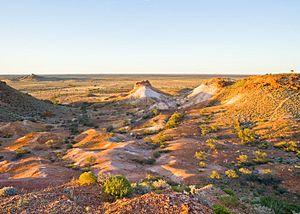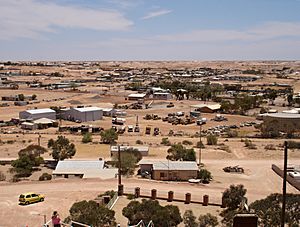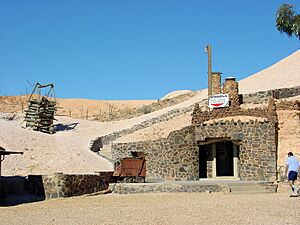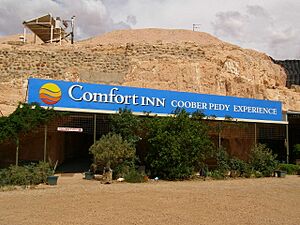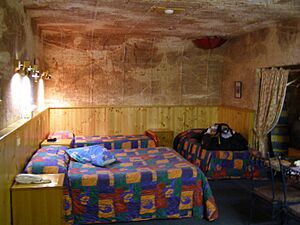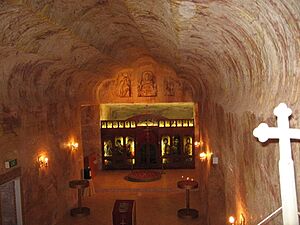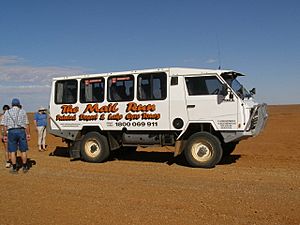Coober Pedy facts for kids
Quick facts for kids Coober PedySouth Australia |
|||||||||||||||
|---|---|---|---|---|---|---|---|---|---|---|---|---|---|---|---|
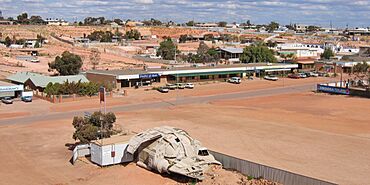
Town centre
|
|||||||||||||||
| Established | 1915 | ||||||||||||||
| Postcode(s) | 5723 | ||||||||||||||
| Location |
|
||||||||||||||
| LGA(s) | District Council of Coober Pedy | ||||||||||||||
| Region | Far North | ||||||||||||||
| State electorate(s) | Giles | ||||||||||||||
| Federal Division(s) | Grey | ||||||||||||||
|
|||||||||||||||
|
|||||||||||||||
| Footnotes | Adjoining localities | ||||||||||||||
Coober Pedy is a unique town in northern South Australia. It's about 846 kilometers (526 miles) north of Adelaide on the Stuart Highway. People often call it the "opal capital of the world" because so many valuable opals are found there. A special mining truck sits above the town sign, showing how important opal mining is to Coober Pedy's past.
The town is also famous for its homes built underground, called "dugouts." People live underground to escape the super hot daytime temperatures. The name "Coober Pedy" comes from an Aboriginal language, meaning "whitefellas' hole." In 1975, local Aboriginal people started using the name Umoona, which means "long life" and is also the name for the mulga tree found there.
Contents
Coober Pedy's Story
Early Days and Opal Discovery
Aboriginal people have lived in the Coober Pedy area for a very long time. They have a deep connection to this land. The name Coober Pedy was chosen in 1920 and comes from Aboriginal words that mean "white man's holes," referring to the mining activities.
In 1858, a Scottish explorer named John McDouall Stuart was the first European to travel near Coober Pedy.
The first opal in the area was found on February 1, 1915, by Wille Hutchison. Soon after, people started moving to the area to mine for opals. By 1916, opal miners were settling in.
Naming the Town
Five years after the first opal discovery, in 1920, the town was officially named Coober Pedy. This was also when a post office was set up.
In July 1975, the local Aboriginal people of Coober Pedy began using the name Umoona. This name means "long life" and is also the name for the Acacia aneura, or mulga tree, which grows a lot in the area. Today, you can find places like the Umoona Opal Mine and Museum using this name.
Where is Coober Pedy?
Coober Pedy is a small town located almost exactly halfway between Adelaide and Alice Springs. It's in the Far North part of South Australia.
Life in the Desert
The Landscape
Coober Pedy sits on the edge of the Stuart Ranges. The ground is made of sandstone and siltstone about 30 meters (100 feet) deep, with a rocky, treeless desert on top. Not many plants grow here because there isn't much rain, water is expensive, and there isn't much good soil.
Underground Homes (Dugouts)
The summers in Coober Pedy are extremely hot. Because of this, many people choose to live in caves dug into the hillsides. These are called "dugouts." Building a three-bedroom cave home with a living room, kitchen, and bathroom costs about the same as building a house above ground.
The best part about dugouts is that they stay at a constant cool temperature. Houses above ground need air conditioning, especially in summer when temperatures can go over 40°C (104°F). The air is usually very dry, and the sky is often clear. While summers are hot, winters can be quite cool.
Water Supply
The town gets its water from the Great Artesian Basin, a huge underground water source. The local council manages the water supply. However, old pipes and water loss mean that water in Coober Pedy is very expensive, the highest in South Australia.
Weather in Coober Pedy
Coober Pedy has a hot desert climate. This means very hot summers and mild winters. Because it's far inland, the weather changes a lot between seasons.
In January, the average high temperature is about 36.7°C (98.1°F), while in June, it's around 18.4°C (65.1°F). The average low temperature in January is 22.2°C (72.0°F), and in July, it's about 6.3°C (43.3°F).
Coober Pedy gets very little rain, only about 144.2 millimeters (5.68 inches) per year. It's a very sunny town, with many clear days and few cloudy days. The hottest temperature ever recorded was 48.3°C (118.9°F), and the coldest was -2.0°C (28.4°F).
In April 2014, Coober Pedy had a big flood when 115 millimeters (4.5 inches) of rain fell in just 24 hours. That's more than three-quarters of the average yearly rainfall!
Mining in Coober Pedy
Opal Mining
Stories from Aboriginal people suggest they knew about opals in the Coober Pedy area but didn't value them as much as food. In 1915, the first opals were found by a gold prospector. Before Coober Pedy, most opal mining in Australia happened in places like Lightning Ridge and White Cliffs in New South Wales.
After World War I, many soldiers came to work in the growing opal mines. After World War II, many refugees and immigrants from Southern and Eastern Europe also found jobs in the mines. At times, up to 60% of miners in Coober Pedy were from these backgrounds. Aboriginal people also worked in the industry starting in the 1940s. The small and flexible nature of opal mining made it a good fit for Aboriginal people, as it allowed them to follow their cultural practices.
In 1945, a local Aboriginal woman named Tottie Bryant found a large opal deposit, which helped the mining industry grow again after a slow period.
Famous Opals
In 1956, a huge opal called the Olympic Australis was found about 9 meters (30 feet) underground. It's the largest and one of the most valuable opals ever mined. It's almost entirely pure opal. The Olympic Australis is 28 centimeters (11 inches) long and weighs 3,450 grams (7.6 pounds). In 2005, it was valued at AU$2,500,000 (about US$1,708,000). It is currently kept by Altmann & Cherny Ltd, a well-known opal company in Australia.
Modern Mining and Opal Types
Around the 1970s, machines started being used more in opal mining. This made digging shafts and tunnels faster and safer.
By 1999, there were over 250,000 mine shaft entrances in the area! Laws about finding and mining opals made it hard for very large companies to take over, allowing individual miners to have small claims. These laws also helped with safety, as many old mine shafts were unmarked and dangerous.
Coober Pedy provides most of the world's high-quality opals. It has more than 70 opal fields. An opalized fossil skeleton of a dinosaur called an Umoonasaurus, nicknamed "Eric," was found near Coober Pedy. This fossil is now in the Australian Museum.
Most opals mined today are gray or white and are less valuable because they don't have the beautiful shimmering colors (called opalescence). Black opals and other precious opals are much rarer and more valuable because of their amazing colors and shine.
Other Mining
Besides opals, other minerals are mined near Coober Pedy.
- In 2009, the $1.15 billion Prominent Hill Mine opened, about 130 kilometers (81 miles) southeast of Coober Pedy. It mines copper and gold.
- In 2010, the Cairn Hill iron ore/copper/gold mine opened near Coober Pedy. It was the first new iron ore mine in South Australia since the 1800s. It closed for a while due to low prices but reopened in 2016.
Oil Reserves
In 2013, a large amount of tight oil (oil trapped in shale rock) was found near Coober Pedy. This discovery could mean Australia might become a country that exports oil.
Visiting Coober Pedy
Coober Pedy is famous for its underground hotels and homes. It has become a popular place for tourists to visit, especially since the main highway was fully paved in 1987.
Today, Coober Pedy relies on both tourism and opal mining to support its community.
Things to see in Coober Pedy include the opal mines, the graveyard, and underground churches like the Serbian Orthodox Church and the Catholic Church. There are several underground motels, some with just a few underground rooms and others where the whole motel is a dugout. The town also gets its power from a special Coober Pedy Solar Power Station that combines solar and other energy sources.
A famous tourist spot is the dugout of "Crocodile Harry," a crocodile hunter and soldier. It's known as 'Crocodile Harry's Underground Nest' and has a collection of bones, art, and messages from visitors. This dugout has even been used as a set in movies like Pitch Black and Mad Max Beyond Thunderdome.
The Umoona Opal Mine and Museum is another popular place to visit.
Every June, Coober Pedy hosts the annual Coober Pedy Opal Festival.
Special Places to See
Coober Pedy has some important historical sites:
- 13 Hutchison Street: A three-room dugout home.
- 9 Hutchison Street: The Coober Pedy Catholic Church and its presbytery (priest's house).
Community Services
The Umoona Tjutagku Health Service Aboriginal Corporation was started in 2005 to provide health services for the local Aboriginal people.
Local News and Entertainment
Coober Pedy has its own newspaper, the Coober Pedy Regional Times, which comes out every two weeks. It started as a newsletter in 1982. You can also find it online.
The town also has local and national radio and TV channels. You can listen to ABC North & West SA 106.1FM for local news, or national stations like ABC Radio National 107.7FM and Triple J 101.3FM.
There are also community radio stations like CAAMA Radio 102.9FM (for Indigenous Australians) and Coober Pedy's own Dusty Radio 104.5FM. For commercial radio, there's Flow FM 99.7.
You can watch five TV channels in Coober Pedy: commercial stations Imparja Television, Southern Cross Central, and 10 Central, plus the government-owned ABC and SBS.
Fun and Games
Golfing in the Desert
The local golf course in Coober Pedy is very unusual – it has no grass! Golfers often play at night using glowing balls to avoid the daytime heat. They carry a small piece of "turf" to use when teeing off. The Coober Pedy Golf Club is the only club in the world that has a special agreement with The Royal and Ancient Golf Club of St Andrews, a very famous golf club in Scotland.
Australian Rules Football
The town has an Australian rules football team called the Coober Pedy Saints, started in 2004. They play in the Far North Football League. Because Coober Pedy is so far away, the Saints have to travel over 900 kilometers (560 miles) for their games to Roxby Downs, where the other teams are located.
Drive-in Theatre
Coober Pedy has a drive-in theatre. It opened in 1965 but became less popular after TV arrived in 1980. It stopped showing movies regularly in 1984 but reopened in 1996. After another drive-in closed in 2022, Coober Pedy's became the last one left in South Australia.
Art Centre
A group of talented artists in Coober Pedy wants to create an Umoona Community Art Centre. They are part of the APY Art Centre Collective, which helps Indigenous artists find work. In 2021, an exhibition in Adelaide showed the work of 24 artists from Coober Pedy.
Transport
You can get to Coober Pedy by bus with Greyhound Australia, which has daily services from Adelaide. The famous train, The Ghan, also serves the town through Manguri Siding, which is 42 kilometers (26 miles) away. The train stops once a week in each direction. Passengers usually can't get off at Manguri unless they have arranged a ride, because it's very isolated and gets extremely cold at night.
Coober Pedy is also a starting point for trips to outback communities like Oodnadatta and William Creek, which are on the Oodnadatta Track. There's a special mail run twice a week from Coober Pedy to these communities and other remote farms. It carries mail, goods, and passengers.
Regional Express also has direct flights to Adelaide from Coober Pedy Airport.
| Preceding station | Journey Beyond | Following station | ||
|---|---|---|---|---|
| Alice Springs
One-way operation
|
The Ghan
towards Adelaide only
|
Adelaide
Terminus
|
||
See also
In Spanish: Coober Pedy para niños



